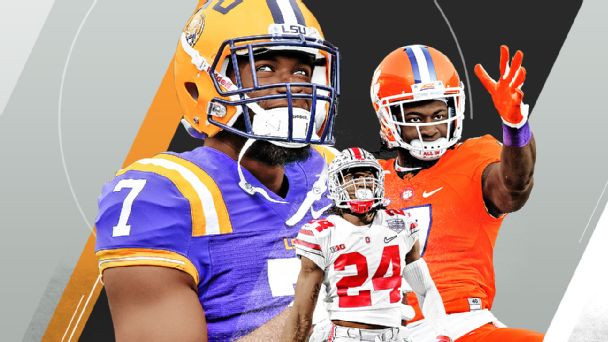With combine looming, Broncos work to 'stay great' on defense

ENGLEWOOD, Colo. — With the NFL’s scouting combine just over a week away, the Denver Broncos’ biggest roster need is undeniable as they evaluate the prospects.
That’s the offensive line. But in the quest to “stay great” on defense, John Elway knows has to look at that side of the ball as well. In particular, he will focus on stopping the run.
“That’s an obvious question,” said Joe Woods, promoted to Broncos defensive coordinator in January after two seasons coaching the team’s defensive backs.
“I’ll give you the obvious answer: Obviously, it’s the run game,” Woods said. “Last year was a little bit different for us in terms of how teams attacked us.”
It is painfully obvious to the Broncos, because despite all that was good in 2016 — finishing No. 4 in total defense, No. 4 in scoring defense and No. 1 in pass defense — Denver’s inability to close down the opposing run game meant it often couldn’t close the deal.
Opponents rumbled to 130.3 yards rushing per game, 28th in the NFL, ahead of only Buffalo, Miami, Cleveland and San Francisco. That isn’t exactly fast company: Cleveland has the No. 1 overall pick in April’s draft, with San Francisco second and Buffalo selecting No. 10.
It’s why the Broncos will take a long look at defensive linemen in the draft and free agency; inside linebackers will also be a focus. Because until Denver shows teams the repairs have been done, it can expect more of the same approach from opposing offenses.
With the Broncos’ secondary often making throwing an exercise futility — all four starters have played in at least one Pro Bowl over the past two seasons — opponents were more than content to pound away. The Broncos faced 482 rushing attempts in 2016.
Only San Francisco (548) and Cleveland (498) faced more rushes than Denver and, again, their combined three wins last season got them the draft’s top two picks.
“We just never got it done,” cornerback Chris Harris Jr. said. “There were times we couldn’t get off the field or keep [offenses] in those situations where you can rush the passer and maybe force some picks, get some hits on the quarterbacks. … We let people off the hook too much.’’
It was an odd mixture of run plays that often saw the Broncos done in by a committee approach. Only two opposing backs rushed for at least 100 yards against the Broncos: the Chargers’ Melvin Gordon and the Raiders’ Latavius Murray.
And those two backs did it in consecutive weeks. Many opposing coaches have said it was a combination of issues for the Broncos — missed tackles and missed gaps — but offenses also felt the Broncos could be worn down because of a lack of depth.
After Malik Jackson departed in free agency and Vance Walker suffered a season-ending knee injury in training camp, the Broncos weren’t able to totally overcome those losses. Toss in a couple of injuries for Derek Wolfe, a hamstring injury to linebacker Brandon Marshall and the recipe was there for some struggles.
NFL draft home page »
• 2017 NFL draft order »
• Mel Kiper Jr.: Mock 2.0 »
• Todd McShay’s Top 32
• McShay: Top prospects by position
• Todd McShay: Mock 2.0 »
• Mel Kiper Jr.’s Big Board »
• Mel Kiper Jr.: Top 10 by position »
• Pro day schedule for prospects »
• Underclassmen who have declared »
• NFL draft player rankings »
So the Broncos will almost certainly use both their impending cap space — expected to top $40 million — to go with some of their expected 10 draft picks to make the repairs.
Coach Vance Joseph has said the team will continue to use a 3-4 scheme as the base defense, as the Broncos have done for the past two seasons. And with nose tackle Sylvester Williams an unrestricted free agent, the Broncos will have a keen eye on that position, as at defensive end, where Walker is also a free agent.
While Joseph is quick to point out that “it’s a passing league” and the Broncos have spent at least 60 percent of their defensive snaps in recent seasons in something other than their base defense, it’s clear Denver won’t force teams to throw into the teeth of its pass defense if it can’t limit the damage better on early downs.
“You look at it overall with what I would call a secondary mindset, because you have to be good against the pass,” Joseph said. “But there’s no question if you let teams run it at you, you don’t get them in those down-and-distance situations where you can do some things.”



 Round 1: April 27, 8 p.m. ET
Round 1: April 27, 8 p.m. ET
